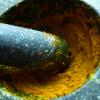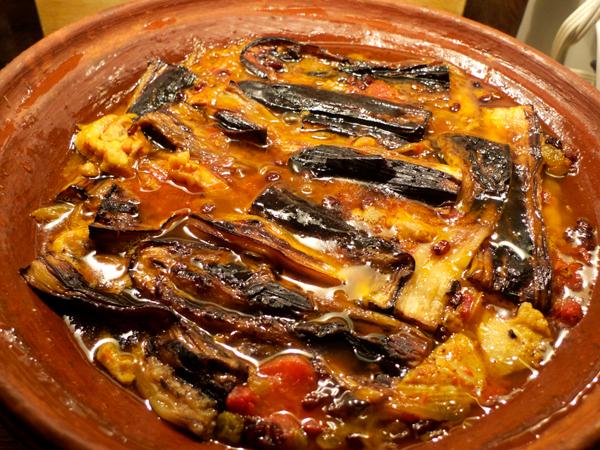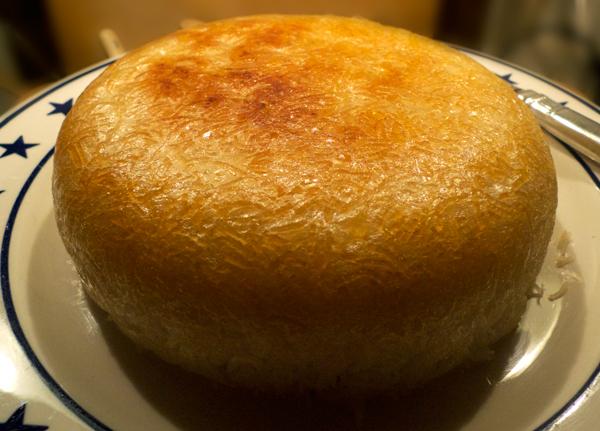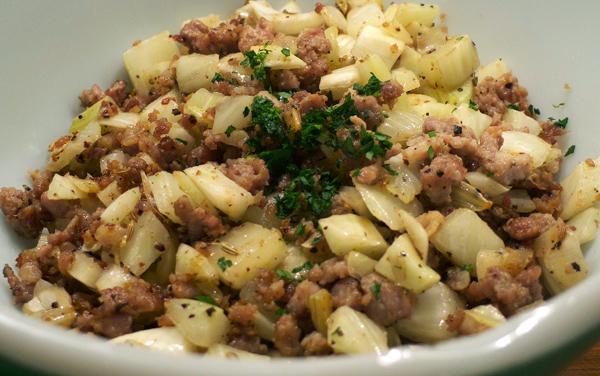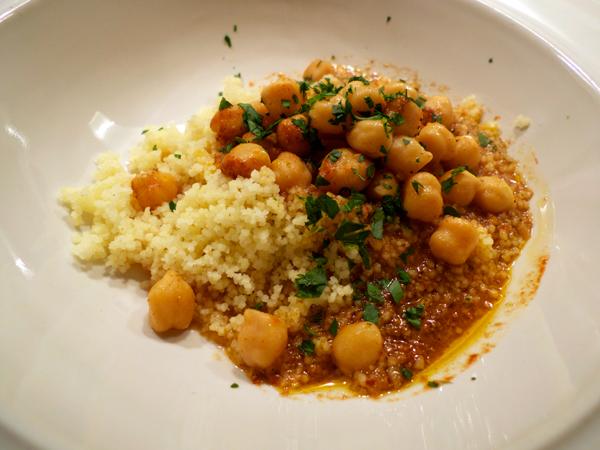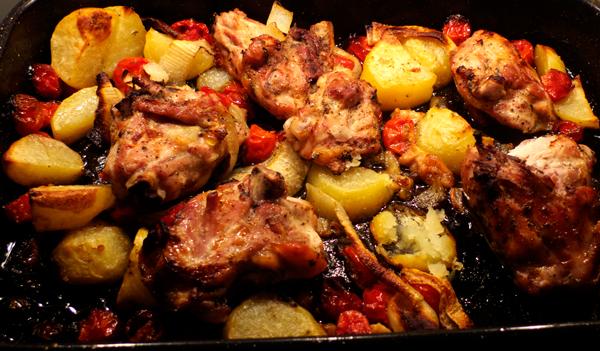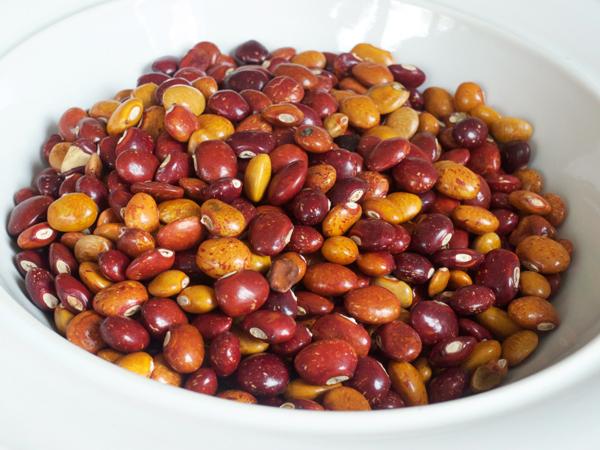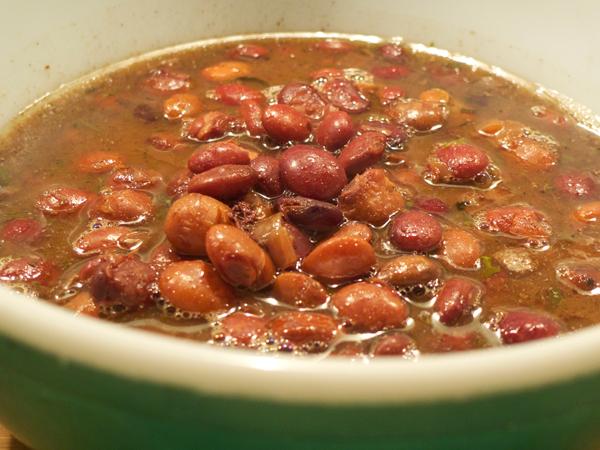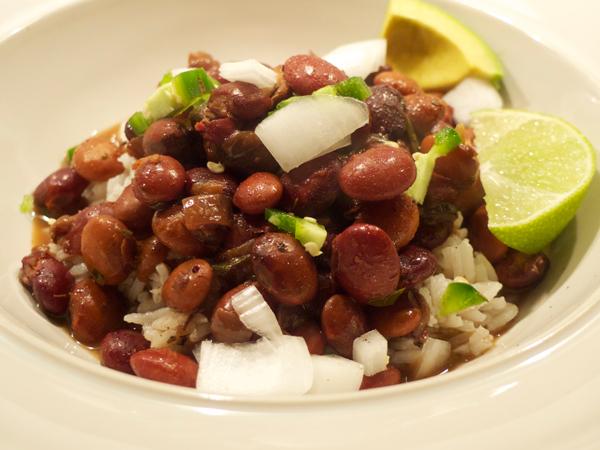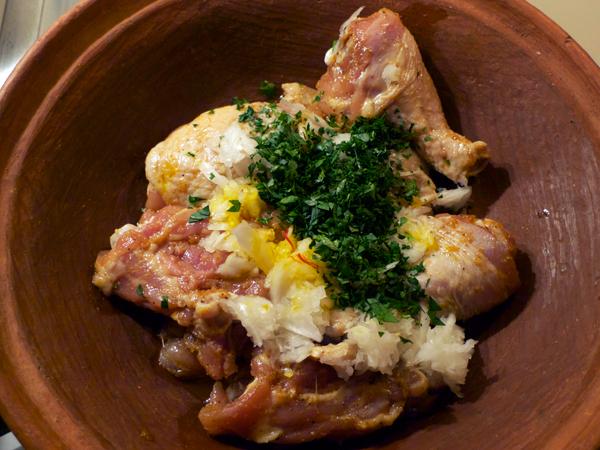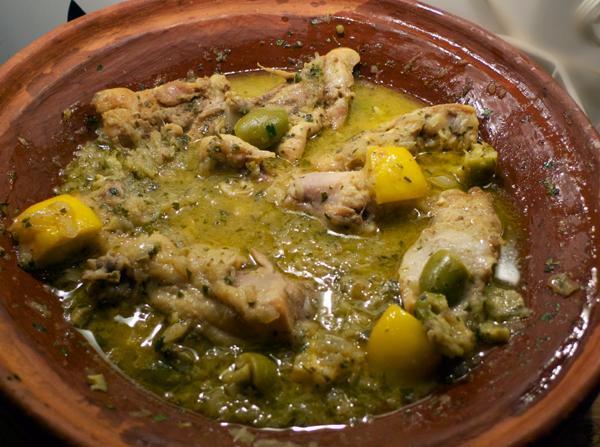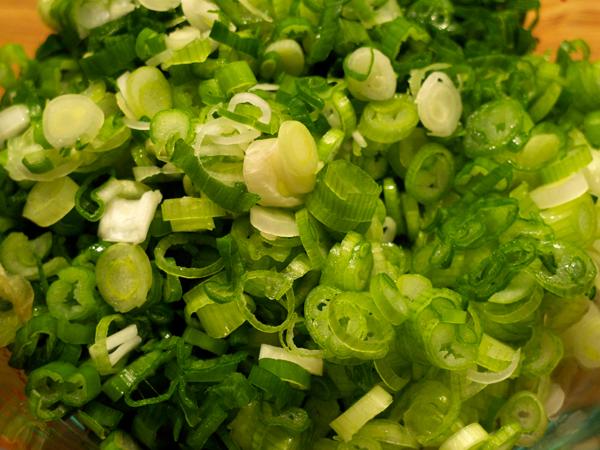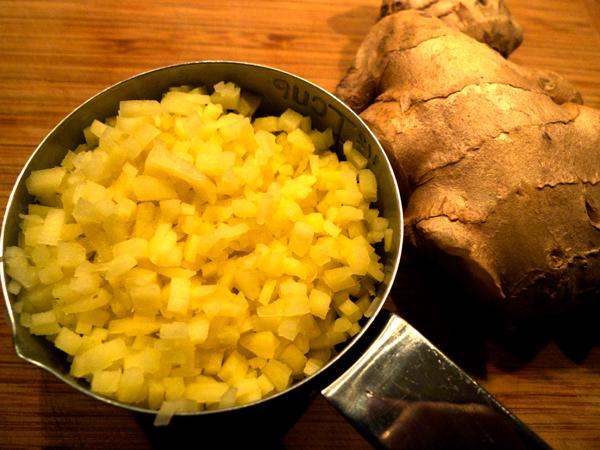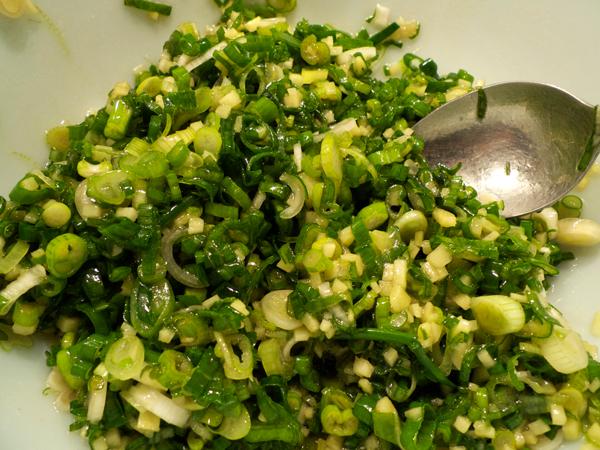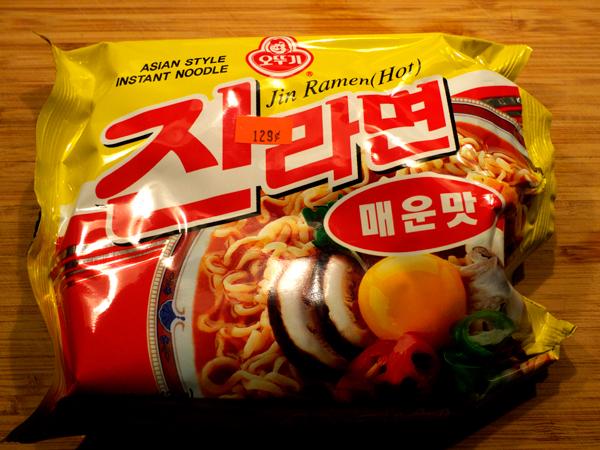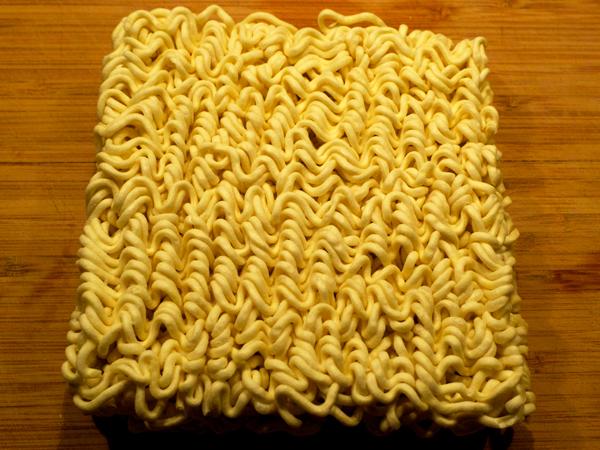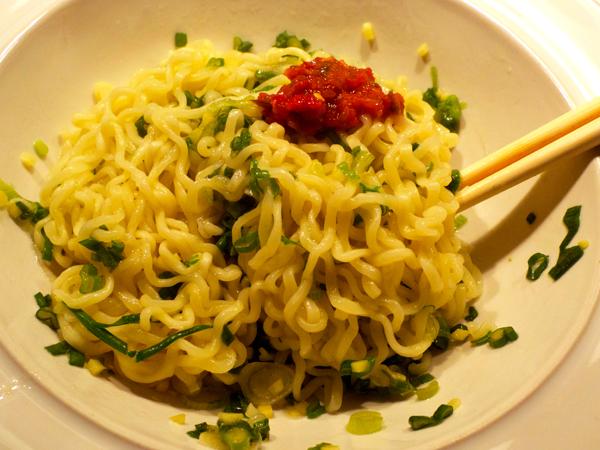-
Posts
1,824 -
Joined
-
Last visited
Content Type
Profiles
Forums
Store
Help Articles
Everything posted by patrickamory
-
Hi seabream, Some random answers to recent questions: - we dried the beef in the oven for about 3 hours at the "warm" setting - peeling the coconuts: just make sure the shell is off, the brown part of the skin doesn't make a difference - warm water and two milking stages makes for better cream and milk than your suggested alternative - hard to specify how much cream or milk a coconut will give off, too many variables. I suggest getting at least 1 more coconut than you need (assuming all the coconuts are good -of the 4 we got yesterday, one was off) Glad to hear the pomelo dish turned out well! There's nothing like fresh kaffir lime leaves. The fragrance is like nothing else. We were fortunate in finding tons of fresh holy basil yesterday. Used two bunches in tonight's pork curry, which was perfect. A couple of tips I noticed were buried in the introductions to the curry sections in David Thompson, don't know whether you noticed, but they are intrinsic to getting the dishes right: - only put in half of Thompson's specified amount of fish sauce. then taste at the end. add more fish sauce to balance if necessary (and of course any of the other ingredients, but if you've added too much fish sauce, it's almost impossible to correct) - for any curry calling for dry spices, only put in half of Thompson's specified amount, and make sure the paste isn't too dry and roasted smelling - "un-Thai" as he puts it - add more if it seems right You can re-read those sections several times, profitably, and I do, frequently. Tonight's meal was a success. I'll post pictures in the Dinner thread tomorrow.
-
My partner who is of Persian descent made an eggplant khoresh tonight. Absolutely delicious! He made it in the tagine and I think that worked perfectly - the Persians apparently historically used a tagine-like clay pot for cooking. The khoresh starts with onions sauteed in ghee, and also contains chicken thighs, tomatoes, an entire teaspoon of ground saffron dissolved in rosewater, caramelized eggplant, cinnamon, golden raisins, barberries and lime juice: Of course no Persian meal would be complete without a tahdig:
-
Never been able to find those in NYC. I soak brined green peppercorns thoroughly in fresh water and use more of them. They're pretty good, but I'm sure they don't come close to the real thing. Some pictures from tonight's prep. The beef strips marinating in a mixture of light soy sauce and palm sugar mixed with a paste made of garlic, salt, coriander roots and white peppercorns: The simple but unusual curry paste, made out of de-seeded soaked dried red chiles, salt, lemongrass, kaffir lime zest, coriander root, roasted coriander seed and roasted cumin: Photos of the finished meal will go in the Dinner thread tomorrow.
-
I'm planning a Thai meal mainly out of David Thompson for tomorrow: - shrimp paste relish (nahm prik gapi) with raw vegetables, page 191 - pork and green peppercorn curry, page 454 - heavenly beef, page 505 I'm pounding the paste for the highly unusual pork curry (recommended, especially if you can find boneless pork shin) this afternoon. I'll also be marinating the beef today and drying it in the oven. Tomorrow afternoon my partner will undertake the dirty work of preparing the coconuts. Tomorrow night I'll deep fry the beef, make the actual curry, and make the relish which is easy to prepare. It will be served with raw apple eggplants, raw snake beans and raw carrots. There will be nam pla prik as well as roasted red chile flakes for the curry, and Victor Sodsook's sweet and spicy dipping sauce for the beef. Jasmine rice.
-
Translation: Only make coconut-based curries (edit: or other dishes, I guess) when you can afford to take the day off work? Well, it's a cuisine that developed off the backs of groups of women who would spend the entire today in courtyard homes doing things like pounding pastes and cracking coconuts. There are of course shortcuts - we now have things like wetgrinders for pastes and food processors for coconut shredding (some people still do the latter by hand). Here's what I recommend: - Make coconut-based curries and dishes on weekends - Makes pastes in advance - they last indefinitely (at least I've gone for months) in the fridge - Get a wetgrinder And remember that not all Thai dishes are curries, and not all curries are coconut-based. Many of the greatest curries - jungle curry for example, or some of the dry red curries - are fried in pork fat or vegetable oil. Salads are simple and fast to make. So is most Thai street food, which is often a high-heat stirfry. Even when it involves, say, drying beef or making sweet pork, you do a little work 24 hours in advance, and a little work the day of cooking. The dish many Thai cookbook authors consider the heart of Thai cuisine, nahm prik (called relishes by David Thompson, and chile water by Soo-mei Yoo), is generally very simple and easy to prepare, and often doesn't involve any cooking at all. Nobody would call classic French cuisine easy, from a properly made ragoût or lamb and artichoke from Richard Olney to soufflés or forcemeats. Same goes for modernist cuisine, some of Diana Kennedy's Mexican recipes and many other pre-modern cuisines. Modern Thai cooks don't cook this way, but they do have access to markets where fresh curry pastes are pounded daily, and fresh coconut cream and milk are freely available. Do plenty of them rely on commercial pastes and canned coconut milk? Probably yes. All I'm saying is that doing it right will yield magnificent results, as with most cooking. If you're going to make Thai curries, and especially coconut-based curries, it's all about the weekends and just getting into the joy of it! Though I have to admit I get less joy out of cracking coconuts than pounding pastes - your experience might vary
-
Gorgeous pics Bruce. I'll be making Thai on Monday but I doubt it will look as pretty as that. I got some of Ottomanelli's excellent sweet sausage yesterday. Brown them over high heat in a cast-iron skillet, added chopped fresh fennel, salt and pepper and sauteed until the fennel was just done, still crunchy. Chopped parsley on the top. Simple and very satisfying. Served with my now ubiquitous Algerian chickpea dersa cooked in the tagine. Used RG garbanzos, but this time soaked them overnight and then a second time during the day, with a little bit of baking soda which is supposed to stop the skins from slipping off. This worked nicely, and I think these were my most successful chickpeas yet, creamy but with a slight pop when biting into them. My partner was feeling sensitive to spice so I replaced the chile powder with a small amount of ground fennel seeds to match with the sausage disih. Served on couscous with more chopped parsley.
-
Just to comment on some general themes that have been brought up since my last post: - Yes, I think that making your own curry paste is superior to any commercial paste, even if you have to sub ingredients. - Beginners might try to find a copy of Su-mei Yoo's out-of-print Cracking The Coconut - she's also a purist, but is more step-by-step than Thompson is. However, you do really have to work your way through the book. You can't just jump ahead very easily. - Similarly, Thompson hides some of his most important tips and comments in the Ingredients section, or in the introductions to the subsequent sessions. So the first time you're making any dish, go back and look at each entry for any ingredient. There will be comments on de-seeding, salting and soaking dried red chiles, for example, blanching pork from a cold-water start, soaking brined green peppercorns if that's all you have access to, and so on. The multiple introductions in the curry section (general, boiled, fried, coconut) are worth reading several times over. - I make my coconut cream as follows. It's a sh*tload of work I'm afraid, but the results speak for themselves. You will need, ideally, a heavy cleaver, an oven, a food processor, cheesecloth, a sieve, at least 3 large bowls and a fridge. The process is sweaty, time-consuming & dirty, so give yourself some time (not good for doing when you come home from work). The following is a combination of Kasma & Su-mei Yoo's procedures. Kasma's are excellent but are somewhat scattered in different sections of her site so somewhat confusing. Try to find and watch her video of how to split a coconut in two halves (linked below) 1. Buy a more coconuts than you are going to use. (Some are inevitably rancid, and it's nearly impossible to tell.) if they have the outer husks, still have a lot of their hair, don't have any visible mold, have covered eyes, are heavy and full of coconut water when you shake them, those are all good signs, but none of them guarantee freshness unfortunately. (Remember, you want the mature brown hairy coconut, not the young green kind sold for its water.) 2. Preheat your oven to 425-450 degrees. 3. Slightly crack each one with one whack from the back (blunt side) of your cleaver, above the sink - making a tiny fissure for draining the coconut water. The smell of the water at this point will tell you whether your coconut has gone bad or not. Drain into the sink. N.b.; coconut water is not coconut milk! It is drunk as refreshment, but the water from young coconuts is preferred for that. I just throw out mature coconut water. See Kasma's comments here: http://thaifoodandtravel.com/features/cocmilk.html 4. Throw out the bad-smelling coconuts. Put the good-smelling coconuts in the oven for 15-20 minutes. 5. Remove from oven using oven mitts and allow to cool. 6. Whack the coconut with the back (BLUNT SIDE) of your cleaver all along what Kasma called the center line, i.e. not the seam but the "equator" of the conconut, perpendicular to the seam. Kasma has a video here: http://thaifoodandtravel.com/features/crackcoc.html Make sure nobody is standing behind you in the kitchen while you do this, because the sharp end of cleaver is flying back each time! 7. If you've done it right, the conconut has split into two halves. Often for me it's 3 pieces or even 4. 8. Here's the most difficult part: pry the meat out of the pieces of shell with a short knife or screwdriver. You may find at this point that some of the conconut meat is moldy and some of it is fine. I always just use the good pieces and discard the bad ones. It's difficult enough finding fresh coconut in NYC. You might be luckier where you live. 9. Many of the pieces of meat will have brown skin attached to them. For most purposes, you can leave this on if it's not too thick and dry. Otherwise, peel it off with a vegetable peeler. 10. Cut the pieces into 2" chunks or so. If they're smaller, no worry. 11. Place in the bowl of the food processor with the blade attachment and pulse and blend until the meat is finely shredded, about 30-60 seconds. Add 1 cup of warm water per coconut used, and pulse and blend another 30-60 seconds, until you have pulp. 12. Remove the mixture to a large bowl, take both hands, reach in, and firmly and rhythmically squeeze and massage (milk) the coconut meat at least 89 times (it's a number important to Buddhists apparently - in any case it gives you a minimum to go for). 13. Place a large sieve over a second bowl, line with cheesecloth, and push all the pulp through it, gathering it up and squeezing it in the cheesecloth to extract the maximum amount of milk. Remove the dry pulp with the cheesecloth and reserve. What you have in the bowl is called the FIRST PRESSING. Cover and refrigerate. 14. Remove the dry pulp from the cheesecloth to the first large bowl, add 3 cups of warm water, and repeat the milking process, 89 times with both hands, being sure to get as much of the pulp between your hands as possible (it's harder now that there's more liquid). Place the sieve over a third bowl, line with fresh cheesecloth, and repeat the process of pushing it through and squeezing out every last drop from the cheesecloth. Discard cheesecloth and pulp. What's in this bowl is the SECOND PRESSING. Cover and refrigerate. 15. After a minimum of one hour, the coconut cream will have separated from the milk in each of the bowls in the fridge. In the first pressing, the cream will be about 1-1/2" thick on the top of the bowl, and will be a thick, creamy consistency - something like strained Greek yogurt. Directly beneath the coconut cream will be the coconut milk, which will be watery and semi-translucent. In the bowl containing the second pressing, the coconut cream will be maybe 1/4" thick and may be floating on top of the milk the way that fat does on the top of chicken stock after you've refrigerated it, in floating pieces like ice floes. Your cream and your milk are now ready to use - and to "crack" - as recommended in the recipe. There are couple different ways (at least) to crack coconut cream. See Thompson's introduction on coconut curries, about a third of the way into the curries section of the book. Any questions, please ask here and I'll do my best to give tips. P.S. Each coconut will give off approximately 3/4-1 cup of coconut cream and 2-3 cups of coconut milk, depending on size, how much meat there is, and how much meat is still good. P.P.S. Coconut cream and milk will go rancid after 1 day, so don't even think about making it in advance.
-
Mmmmm that looks mouthwatering Andie.
-
Kim Shook the Momofuku noodles are that easy, and they are really more-ish. I would add a bit more of the light soy sauce than he specifies - quite a bit more in my case, but it probably has to do with the kind of soy sauce you have (he recommends usukuchi, and I only had Pearl River - I don't know how different they are).
-
I cook from David Thompson non-stop and I find he is right on most of his purist attitudes. - Fresh coconut cream beats canned coconut cream hands down. There is no comparison. It's almost impossible to crack canned coconut cream properly due to the flour additives (see the cracking coconut cream thread) - Homemade curry pastes are so far superior to pre-made ones it's not funny That said, I think some of your shortcuts are fine, and I'll add a couple of my own: - Regular lime zest can replace kaffir lime zest - you might need a little more of it, do it to taste - A combination of chopped cilantro stems & leaves can replace the roots, again you'll need more, and the volume will change the consistency and proportions of pastes, so keep that in mind - Regular ginger can substitute for both young ginger and krachai (grachay, lesser galangal) - again you will need to play around with quantities and taste - Brined green peppercorns can substitute for the unfindable fresh, just be sure to soak them in cold water for at least 30 minutes, and use more - Holy basil - fresh, real holy basil is extremely difficult to find and goes bad in 24 hours - and it is incredible - make sure you're not being sold Thai basil under the name holy basil. But if you can't find it, try using a mixture of Thai basil and fresh mint leaves Some things you can't substitute very easily... you will need high-quality fish sauce, shrimp paste and jasmine rice. You should use real fresh bird chiles and real dried red Thai chiles. Nothing will substitute for galangal and lemongrass. Do not substitute onions for red shallots. And try to get small, purple garlic rather than the immense supermarket garlic cloves we usually find. I would check Kasma Loha-unchit's website for brand recommendations on the above ingredients, which focus on what you can get in the US: http://thaifoodandtravel.com/brands.html It is an absolute pain in the ass to make fresh coconut cream, I realize... if you can't deal with it, then I suggest buying coconut oil and mixing it with canned coconut cream. But you're not going to get rid of that floury texture. Better to just make curries that don't call for coconut. There are plenty of them. My favorite recipes include the dry red curry of lobster (adaptable to just about anything, doesn't require coconut cream), the highly unusual curry of pork with fresh green peppercorns (under "menus"), the royal salad of grilled prawns with kaffir lime juice mixed with mandarin orange juice, heavenly stirfried beef with holy basil, papaya salad with sweet dried pork, the marinated dried deep-fried beef sticks, and the jungle curry (to die for). If you have to do coconut recipes, the green and red curries are superb. But they need fresh coconuts! The most important thing Thompson has to teach besides the importance of ingredients is the importance of balancing flavors at the end of each dish. It sounds to me from your post that you're not doing this. I would try his flavoring exercise (or the one on Kasma's site above) to learn how to balance flavors. In the world of extremely intense Thai flavors, it only takes a slight imbalance to throw the entire dish off. The key thing is only to put half the fish sauce in that's recommended - he writes about this in the intro to the curries section. That saltiness will be the hardest aspect to correct if you put in too much. And there are so many factors, not least the basic flavor of the paste (which you should be smelling and tasting as you make it, ingredient by ingredient). Then at the end - the very end - taste the dish, and carefully adjust - fish sauce for salt, palm or white sugar for sweetness, tamarind or lime for sour, and bitter ingredients for bitter. But it's the first two that are most likely to be out of whack. If you've held back on the fish sauce, you've given yourself room to maneuver.
-
kaybee and Katie, I used grape tomatoes which I cut in half. I find these tomatoes to be relatively sweet and crisp year-round compared to larger ones, and they caramelized nicely. Canned tomatoes felt wrong for this dish - you want a little bit of that skin and pop. And Katie, interesting point about the skin. It crisps so much during the first stage of cooking that it retained its crispness even after being turned over, though some of it stuck to the bottom. It might well be possible to cook it without turning at all. robirdstx, it was definitely you or djyee100 who turned me on to the recipe. Thanks! and... awesome looking crawfish etoufee.
-
Pollo alla calabrese. Someone in this thread hipped me to this recipe, which I think might come from Rosetta Constantino's My Calabria. The link I'd bookmarked was this: http://napavalleyregister.com/lifestyles/food-and-cooking/recipes/pollo-alla-calabrese-baked-chicken-with-potatoes-tomatoes-and-hot/article_1d170f8a-3322-11e0-bf7b-001cc4c002e0.html I followed the recipe pretty faithfully, except that I added minced red vinegar peppers as well as crumbled dried red chiles. It's pretty amazing how crispy the chicken thighs get, and how thoroughly the glaze cooks down... while everything remains soft and juicy. I think it might be the combination of high heat and the pan sitting down at the very bottom of the oven.
-
Enrique - looks delicious! Seems like a very satisfying combination.
-
A friend brought me back a bag of these pretty-looking rum beans from Chiapas: I brought them to a boil in water with a couple tablespoons of bacon fat, some vegetable oil, chopped white onion, sage and some smashed garlic cloves in a clay pot, and then simmered them covered for about 2 and a half hours, adding salt halfway: Served on rice with chopped white onion, chopped fresh jalapenos, lime wedges, avocado and tortillas:
-
Hi Linda - La Bonne Cuisine de Madame E. Saint-Ange - that's exactly what I was thinking about. Worth picking up? I have Child and Olney. I realize this is something different, probably a reference work as much as anything else.
-
Oh wow that hummus looks so good! I'm curious about that spice mixture Andie. It's an intriguing combination. I have rose petals and rosewater - maybe I'll experiment a bit.
-
It looks delicious to me andie! I know Moroccan is not the same Lebanese, but there are more tagines coming in my life... just sauteed some garlic, cayenne and paprika in olive oil and added to olives with lemon juice and lemon zest to marinate for an olive and potato tagine.
-
Thanks Andie. I love eggplant too. Will see whether Kalustyan stocks these.
-
I'm with Shalmanese. There's no one size fits all, and the level of liquidness is paramount in deciding which one will work best (at least for me, with my particular blender and food processor models). To get more specific, you can't get as fine a puree in a food processor as you can in a blender, but if the mixture is too dry or too thick, the blender simply will not work. Equally, if there isn't enough volume, the food processor won't work. The combo suggested by Shalmanese is sometimes the only solution.
-
Hi Andie, tell me more about Aleppo pepper. I'im intrigued.
-
rro that chicken looks heavenly. dcarch unbelievable-looking SV corned beef. And nice touch with the shamrock leaves!
-
Wow, yummy corned beef sandwiches everyone. Shelby, could you post the King Arthur Flour rye bread recipe? Sounds intriguing. kayb both the barbecue and the pie shop look incredible.
-
I finally decided to make chicken with preserved lemons and olives in my tagine. I went out to buy Paul Wolfert's clay pot book but the bookstore was sold out of it, so I was forced to use a decidedly unhelpful rendition of the recipe on yummly.com. I cut corners in several ways - did not stuff garlic and salt under the chicken skin to rid it of bitterness (I used a high quality chicken), and only marinated for three hours at room temp as opposed to overnight in the fridge. I also used preserved lemons from Kalustyan because my homemade ones won't be ready for another two weeks. Still turned out great. I have to say this is a surprisingly time-consuming recipe compared to the times given - again, this may have been the layout of the recipe on the site (which I definitely don't recommend). The marinated chicken with the grated onion, saffron and herbs added, ready to go in the tagine: And the final dish, ready to serve:
-
Probably not what you're looking for, but growing up we had the marvellous La cuisine est un jeu d'enfants by Michel Oliver http://www.amazon.fr/La-cuisine-est-jeu-denfants/dp/2259001807/ref=sr_1_2?s=books&ie=UTF8&qid=1332089219&sr=1-2 I also seem to remember there's a classic French cookbook sort of equivalent to the Italian Silver Spoon that surveys all the cuisine of the regions. It may well have been translated.
-
After owning it for a few months, I finally tackled a recipe from the Momofuku cookbook. This was noodles with ginger and scallion sauce. First, the chopped scallions: And the chopped ginger: Combined with light soy sauce, sherry vinegar, oil and salt: Taking a tip from Ruth Bourdain's article in the first issue of Lucky Peach, I got some packaged ramen noodles from the local Korean grocery, Han Ah Reum, and discarded the flavor and vegetable packets: And the final dish, with some Vietnamese chili-garlic sauce. Incredibly easy to make. And I have extra ginger-scallion sauce in the fridge.


